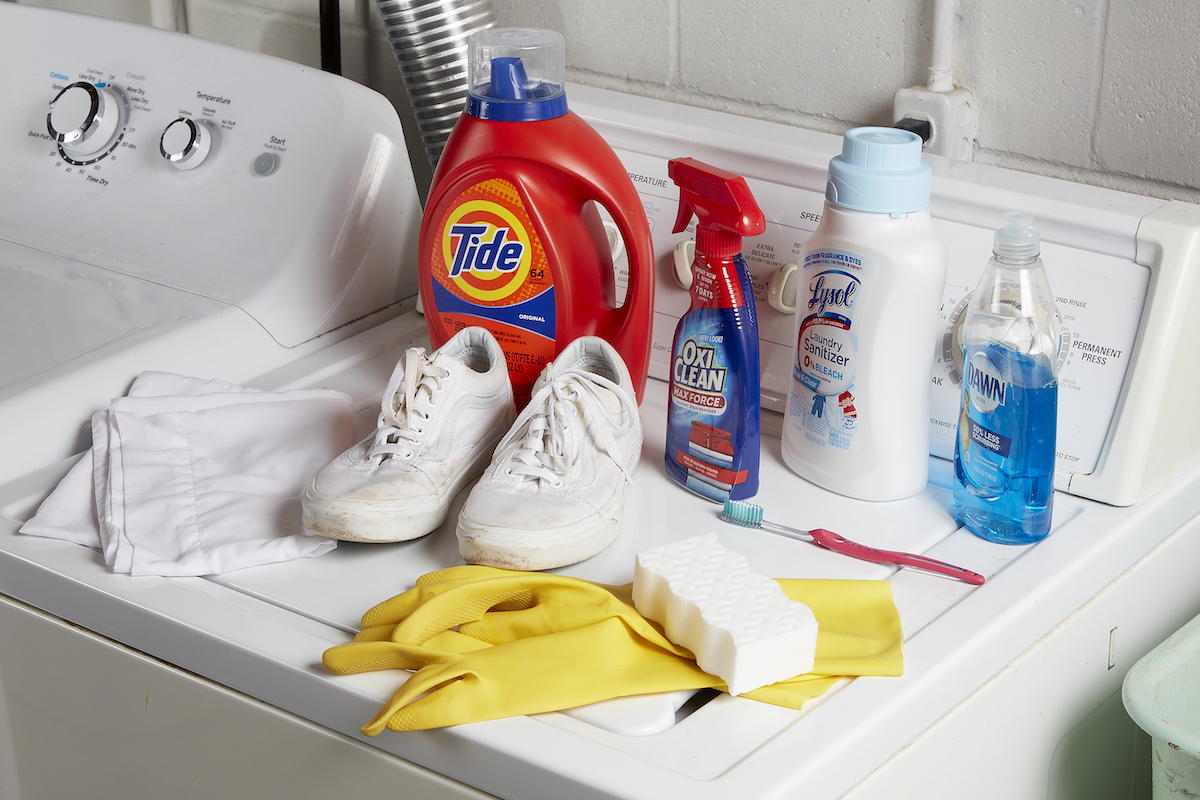

We may earn revenue from the products available on this page and participate in affiliate programs. Learn More ›
While you generally get what you pay for when it comes to apparel, a good pair of sneakers is probably going to cost you a pretty penny. Athletic shoes, particularly the super-high-tech varieties, are costly to manufacture, but many get their high price tag simply because they are status symbols or the products of celebrity collabs. Certain athletic shoes are also highly collectible, with self-described sneakerheads plunking down hundreds, if not thousands, on the kicks they covet.
Whether or not you’re a serious sneaker snob, keeping your shoes clean is crucial to getting your money’s worth out of them. Follow this guide for steps on how to wash shoes in the washing machine—and what to do if your favorite pair can’t go in the washer.
Which shoes can go in the washing machine?
First things first: Determine whether the stinky shoes in question are machine-washable. Some types of shoes will survive a sudsy spin in the washer, no problem—think canvas kicks like Keds, classic Chucks, and Toms—and some will not.
Athletic shoes made from fabric (usually nylon or polyester), whether you wear them for workouts or solely for the comfort factor, are generally OK to machine-wash as well.
Dress shoes, heels, leather sandals, boots, or any footwear with embellishment like beads or buckles aren’t washer-friendly, nor are shoes with rubber or metal cleats.
Lastly, plastic shoes such as flip-flops, garden clogs, and Crocs can be machine-washed on the gentle cycle, but it’s probably easier to rinse them in the sink. Use a rag and some gentle soap, if necessary.
Tools & Materials
Bobvila.com may earn a commission from purchases made through these links.
- Washing machine
- Small scrub brush, nail brush, or old toothbrush
- Mesh laundry bag or pillowcase
- Newspaper or small towels/washcloths
- Laundry detergent
- Laundry sanitizer (optional)
- Stain remover (optional)
- Eraser-style cleaning sponge
- Several large towels
Step 1: Pretreat and prepare the shoes for the wash.
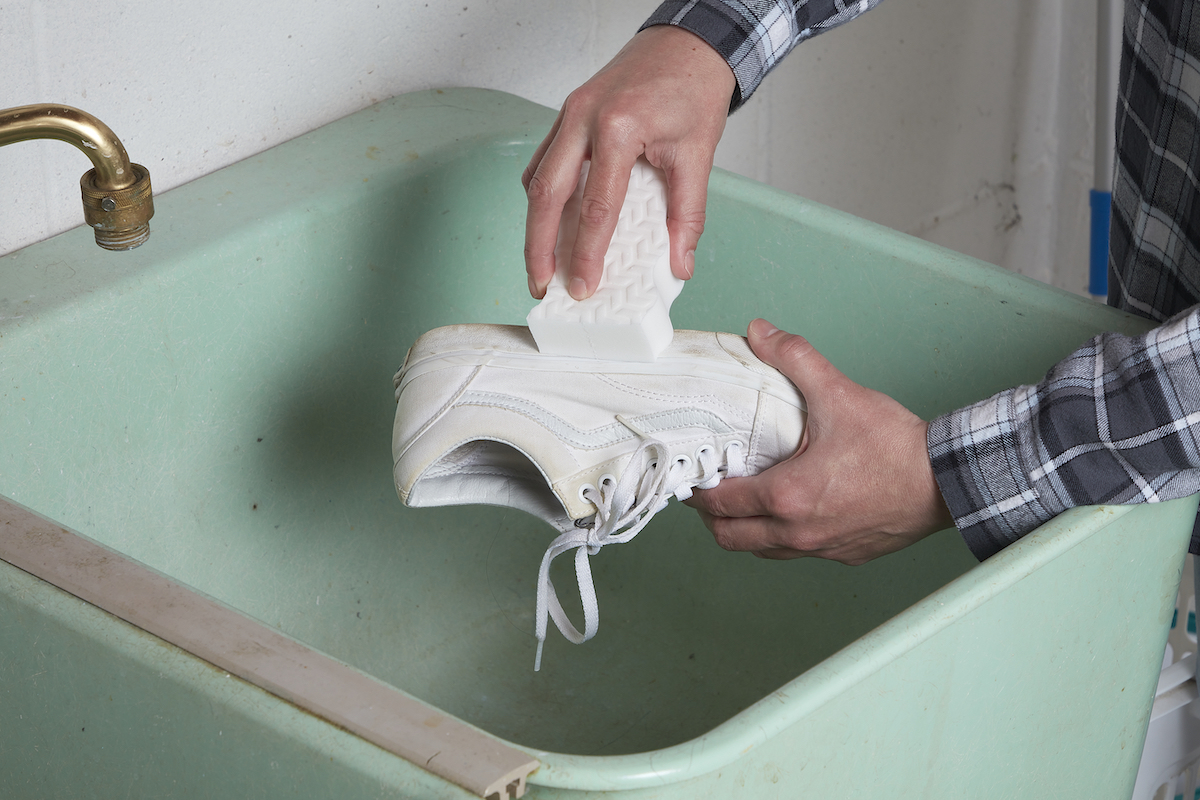
Shoes with scuff marks or stains should get a little personalized attention. Tackle scuff marks and grime along the sole with an eraser-style cleaning pad (a melamine sponge like the Mr. Clean Magic Eraser), and scrub stains with mild soap and a gentle brush. A nail brush, or even a toothbrush, works well for this step.
Sneakers with fabric uppers, like those made by Converse, can also be treated with stain sprays or sticks. Follow the product’s directions to remove oil, blood, ink, grass, or other common stains.
Remove any liners, insoles, orthotics, or laces. That said, shoelaces can go along for the ride, if you’d like, as can inexpensive cloth insoles. Custom orthotics, gel cushions, or any inserts that aren’t made of fabric should be cleaned by hand. Always follow the care instructions that came with the inserts, but here are some general cleaning guidelines:
- Custom orthotics: Wipe orthotics with a slightly damp cloth; do not saturate them with water. Avoid chemical cleaners, although you can use a little bit of mild dish soap. Allow the orthotics to air-dry completely. To neutralize odors, put the orthotics into a small bag, sprinkle with baby powder or baking soda, and let sit for about an hour. Remove from the bag and wipe off the powder.
- Gel cushions and foam insoles: Wash in warm, soapy water. Scrub gently, if necessary, and air-dry completely. Alternatively, wash them in a 50-50 mixture of distilled white vinegar and water. For odor removal, put them in a bag, sprinkle with baby powder, and let sit. Wipe off the excess powder.
Step 2: Stash shoes and laces in a pillowcase or lingerie bag.
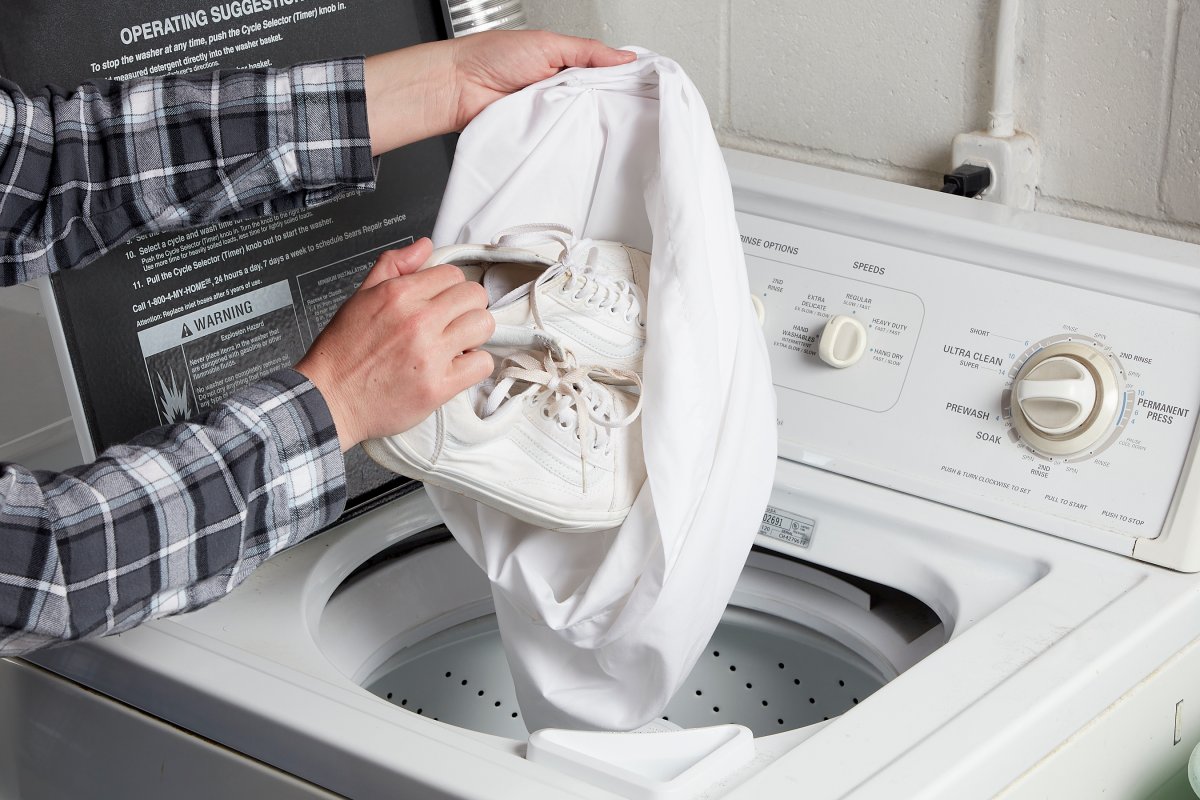
A mesh lingerie bag that you would use for washing bras or other delicate items is also good for laundering shoes. If you don’t have one of those, no worries—you can use an old pillowcase, preferably one with a zipper. If the pillowcase lacks a zipper, secure it with a rubber band or knot the fabric loosely.
Place the shoes and laces inside the mesh bag or pillowcase, and then toss the bag into the wash. Don’t stick your kicks in with a regular load of clothes or household laundry, but do add a couple of old towels to the drum. A few bath or beach towels will help cushion the shoes as they bounce around inside the machine, cutting down on noise. They will also help keep the washer balanced.
RELATED: The 13 Best Things You Can Buy for Your Laundry Room (for Under $50)
Step 3: Run a delicate wash cycle.
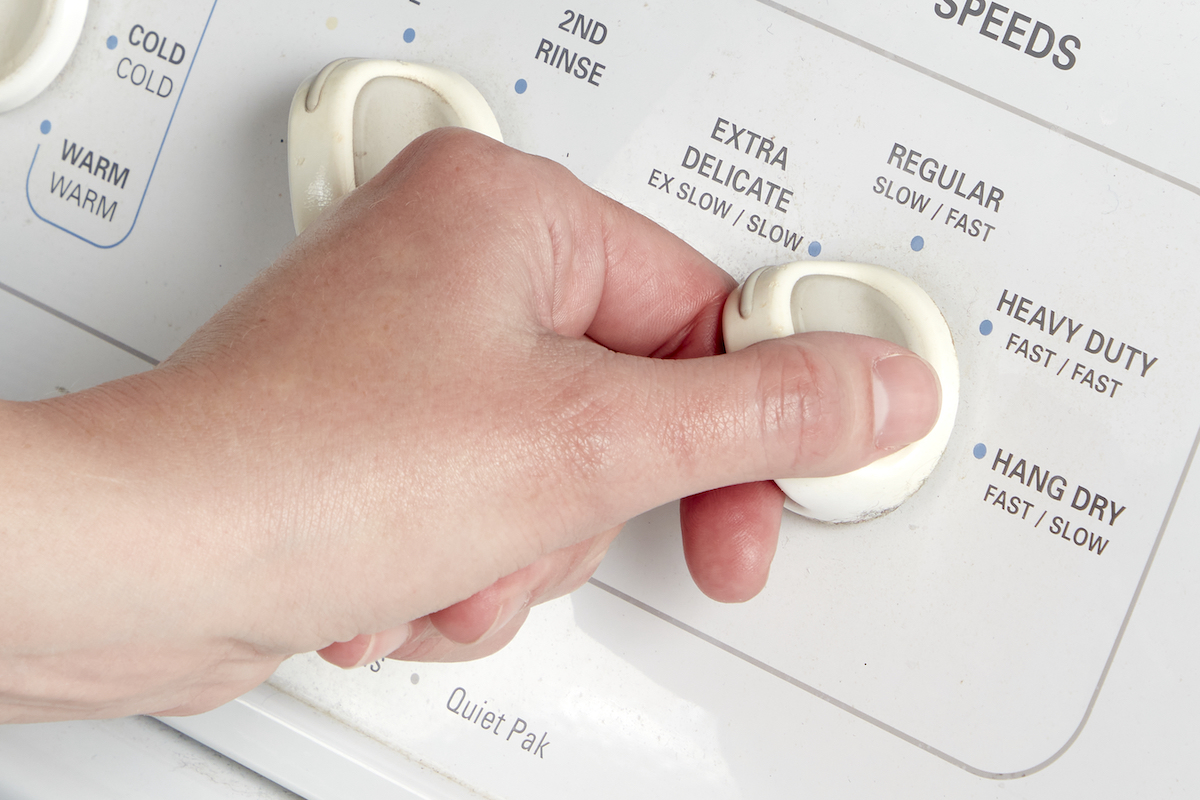
Select the shortest possible setting, which is generally the gentle cycle. Add detergent, but use much less than you would for a full load, and be sure to choose a liquid, not powder, laundry soap.
Although you might be tempted to run a hot wash, it’s better to use cold water. Hot H2O can start to degrade the glue that holds shoes together. If your sneaks are very stinky, it’s not a bad idea to use a laundry sanitizer as well as your usual detergent. Sanitizers remove bacteria and, by extension, odors; they’re typically added during the rinse cycle, but check the instructions. To help combat smells, you can also sprinkle the insides of the shoes with baking soda the night before you wash them.
Step 4: Dry the shoes.
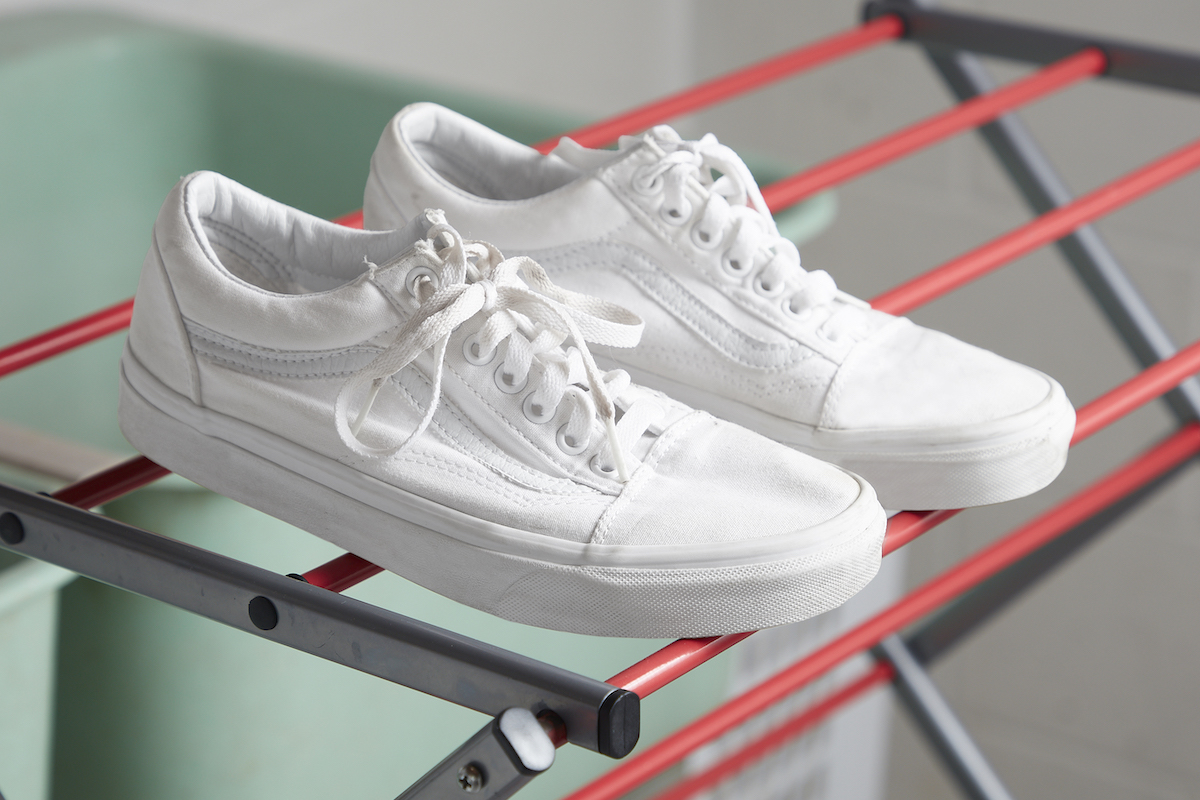
When the wash cycle ends, remove your formerly foul footwear from the bag or pillowcase, but don’t toss your shoes in the dryer. Because the high temps and tumbling action of the dryer can be bad news for your footwear’s glue, soles, and other materials, it’s generally recommended that shoes be air-dried.
To hasten the drying process and help your sneakers retain their shape, stuff them with balled-up newspaper, washcloths or rags, or even a few pairs of socks. Wait until the shoes are thoroughly dry before replacing the laces or insoles. It might take a few hours or even overnight, so plan ahead to avoid having to wear still-damp sneakers—never a nice feeling.
Using the dryer may not be totally out of the question, though. Several appliance manufacturers, including LG, Whirlpool, and Samsung, produce racks that fit inside the drums of certain dryer models. These racks, typically sold as optional accessories, remain stationary while the drum turns, so you can use them to dry sneakers, wool sweaters, and other items that shouldn’t be tumbled dry. Dryers that can accommodate these racks may have a Rack Dry cycle, but if not, choose a low temperature setting.
RELATED: How to Wash Shoes in a Washing Machine
How to Clean Shoes Without a Washing Machine
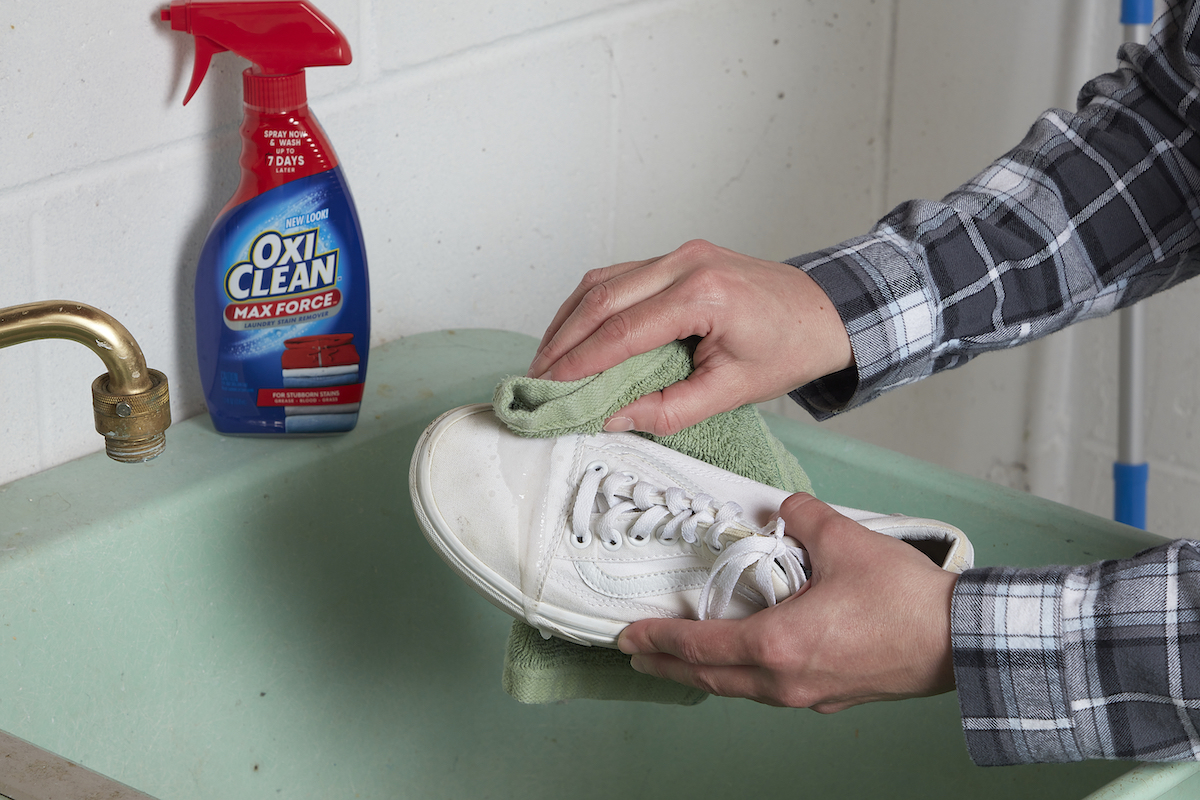
Plenty of shoes can’t be tossed in the washing machine, and even machine-washable shoes sometimes just need a little spiffing up, not a complete soaking. For these situations, here are some options beyond machine-washing. (Note: Always remove laces before cleaning, and don’t forget to wash the laces too.)
- Canvas and other washable sneakers: Use a soft brush or toothbrush to remove loose dirt. Mix warm water with a small amount of mild dish soap or laundry detergent. Dip a clean, soft brush into the soapy liquid and scrub the soles of the shoes, and then clean the brush and scrub the uppers. Blot dry with a microfiber cloth, and repeat until the soapy water is largely removed. As an alternative for white shoes, make a paste of 3 parts baking soda to 1 part vinegar. Using a small brush or old toothbrush, scrub the paste onto dirt and stains, letting it harden. Once dry, rub off with a clean rag or paper towel.
- Suede shoes: Brush away loose particles with a suede brush (or another soft brush), and then use a suede eraser (or a clean clear or white gum eraser) to rub out dirt and marks. For tough stains, lightly dampen a microfiber cloth with vinegar, rubbing alcohol, or a suede cleaning solution, and press it into the stain. Let dry; repeat, if necessary. To keep your shoes looking good, consider applying a suede protector.
- Leather shoes: Use a horsehair brush to clean off loose dirt, and then insert shoe trees or crumpled paper so the shoes retain their shape. Apply saddle soap, using a damp soft-bristle brush. Work up a lather, and then wipe down with a microfiber cloth. Let the shoes dry completely (at least 8 hours), and then rub in small amounts of leather conditioner, using a clean microfiber cloth and working in small circles. Let dry, and then polish up with the horsehair brush. If desired, apply tinted cream or wax polish.
- Faux leather: Wipe down with a clean microfiber towel dipped in warm, soapy water, dry with a clean towel, and let air-dry completely.
Final Thoughts
Whether they’re running shoes, canvas slip-ons, or casual cloth sneakers, a good pair of sneakers is like a good friend. You rely on them week in and week out to support you. Knowing how to clean them properly in a washing machine will not only keep them looking great but will also extend their lifespan.
While the washing machine can be a useful tool for this purpose, be cautious. Don’t machine wash shoes made of leather or suede or any shoe with a hard sole. Boots are also verboten in the washing machine. (The exception to this rule? Already beat-up athletic shoes that you still choose for chores like mowing the lawn or messing around in the muck. If you don’t care whether the leather cracks, go ahead and throw ’em in.)
